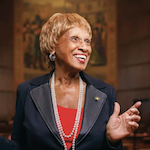Women Breaking Barriers in Government
What does it feel like to be the only female legislator in a room of powerful men?
On her way to a meeting, she is mistaken for a secretary and one of her new colleagues asks her to fetch a cup of coffee. She takes a seat at the long table and feels the gaze shift to her face and body which do not fit into this group of suits and ties. She was overqualified for office, but nobody seems to hear her ideas. She is excluded from the happy hours and golf outings, occasions where the men laugh and forge friendships—networks which will carry them up the rungs of power.
This was the story of the American government. And today, that story is changing.
Oregon is one of four U.S. states with at least 40 percent women in the legislature. It also boasts a female governor, speaker of the house, attorney general, secretary of state, and chief justice. With 28 female representatives and nine senators, it’s one of the most gender-diverse legislatures in the nation’s history.
Six Oregon lawmakers graciously shared their experiences, their views on the demographics of leadership, and their advice so that the path to government might be more navigable for other women who are interested in running for office.
 Representative Teresa Alonso León Rep. Teresa Alonso León is the first indigenous woman and Latina immigrant to be elected to Oregon’s House. She is widely admired for her efforts to protect working families and promote inclusiveness within higher education.
Representative Teresa Alonso León Rep. Teresa Alonso León is the first indigenous woman and Latina immigrant to be elected to Oregon’s House. She is widely admired for her efforts to protect working families and promote inclusiveness within higher education.
“Having come from an immigrant, indigenous background whose family gave up so much for me to be in this country, I just feel such a responsibility to give back…We need those amazing talented people to be in the office—especially folks of color, especially women—but we just don’t have a system that can support them right now.”
 Senator Sara Gelser Sen. Sara Gelser has fought tirelessly to strengthen child abuse statutes and to protect other vulnerable populations. President Obama nominated her to the National Council on Disability in 2010, where she received a unanimous vote from the U.S. Senate. Notably, she was named a 2017 TIME “Person of the Year” for breaking the silence on sexual harassment in the capital.
Senator Sara Gelser Sen. Sara Gelser has fought tirelessly to strengthen child abuse statutes and to protect other vulnerable populations. President Obama nominated her to the National Council on Disability in 2010, where she received a unanimous vote from the U.S. Senate. Notably, she was named a 2017 TIME “Person of the Year” for breaking the silence on sexual harassment in the capital.
“I’ve been here for 15 years. Our ranks have grown. It used to be that all the women could fit in one House office, and House offices are little. When we look at barriers to participation—whether it’s for women or people of color—it’s a mistake to think that all of that is put in place by white men. Institutions are built on cultural and gender assumptions; women can reinforce and be the gatekeepers for sexist assumptions.”
 Senator Betsy JohnsonSen. Betsy Johnson is the co-chair of the powerful Joint Committee on Ways and Means, where she has served since her first term. Before being elected, she was a licensed pilot for fixed- and rotary-wing aircraft and founded an aviation company. In 2018, she received an impressive 82 percent of her constituents’ votes for reelection.
Senator Betsy JohnsonSen. Betsy Johnson is the co-chair of the powerful Joint Committee on Ways and Means, where she has served since her first term. Before being elected, she was a licensed pilot for fixed- and rotary-wing aircraft and founded an aviation company. In 2018, she received an impressive 82 percent of her constituents’ votes for reelection.
“I believe I was the first woman carded by the Forest Service to do work with a long line of forest fires. This means I was credentialed; they call it ‘carding.’ And the guy that was supposed to do the check rides for the FAA wouldn’t fly with me because I was a girl!”
 Senator Laurie Monnes Anderson Sen. Laurie Monnes Anderson is the president pro tempore of Oregon’s 80th Legislative Assembly. She was a public health nurse for over 20 years in East County—an experience which informs her commitment to underserved groups. She is renowned for her dedication to affordable housing, raising the minimum wage, and making quality healthcare accessible to all Oregonians.
Senator Laurie Monnes Anderson Sen. Laurie Monnes Anderson is the president pro tempore of Oregon’s 80th Legislative Assembly. She was a public health nurse for over 20 years in East County—an experience which informs her commitment to underserved groups. She is renowned for her dedication to affordable housing, raising the minimum wage, and making quality healthcare accessible to all Oregonians.
“The younger women are different. They are much more astute in not accepting some behaviors. I admire that and I’m sure it has to do with them having many more rights than I had when I was younger. For women in the 1950s, you were a secretary, you were a nurse, or you were a teacher. Those were the three things that you studied.”
 Representative Nancy Nathanson Rep. Nancy Nathanson was elected to Oregon’s House in 2006 and is respected for her role in shaping OregonSaves, a statewide retirement program. Prior to joining the legislature, she was a small business owner and served on Eugene’s Planning Commission and City Council.
Representative Nancy Nathanson Rep. Nancy Nathanson was elected to Oregon’s House in 2006 and is respected for her role in shaping OregonSaves, a statewide retirement program. Prior to joining the legislature, she was a small business owner and served on Eugene’s Planning Commission and City Council.
“Women are still the primary caregivers for families. Usually, that means kids, but sometimes it’s the parents who may be elderly or disabled. It can be self-limiting because women believe they can’t give as much of their time…I saw things that I wanted to improve, and I think for many women that’s how we end up being involved. We’re trying to make people’s lives better.”
 Senator Jackie Winters Sen. Jackie Winters is the first black woman ever elected to Oregon’s legislature. She is also the state’s longest-serving black senator and soon to be the longest-serving Republican woman in Oregon’s history. She is revered on both sides of the aisle for her commitment to criminal justice reform; her role in creating the Oregon Food Bank; and her organizational leadership.
Senator Jackie Winters Sen. Jackie Winters is the first black woman ever elected to Oregon’s legislature. She is also the state’s longest-serving black senator and soon to be the longest-serving Republican woman in Oregon’s history. She is revered on both sides of the aisle for her commitment to criminal justice reform; her role in creating the Oregon Food Bank; and her organizational leadership.
“Maybe it’ll be a little rough-elbowing to begin with, but I think about those who came before me—the Betty Robertses and the Norma Pauluses of the world—who I admired. There’s always somebody that came before us. There’s always somebody who actually took the brunt of what we’re all feeling and seeing.”
Jump To:
- The American Government: An Old White Boys’ Club
- Women in U.S. Government: The Numbers
- Why Aren’t There More Women in U.S. Leadership?
- How Does Having More Women in Leadership Affect National Outcomes?
- Institutional Reform: How to Increase Women’s Representation
- Barrier-Busting Advice for Aspiring Leaders
The American Government: An Old White Boys’ Club
”My view was always don’t get mad—outfly them, outwork them, outthink them, outmaneuver them. So my best revenge was just doing it better than the people that had been distractors. And in my day, I was a pretty damn good low pilot.” (Senator Betsy Johnson)
One hundred years ago, American women finally got the right to vote, but the country’s lawmakers have never reflected the diversity of its citizens.
Since 1789, only 2.9 percent of all U.S. legislative members have been female. Although women now make up 23.7 percent of the 116th Congress—a new record—this falls far short of our 51 percent majority in the population.
Even more alarmingly, this historic percentage is still less than women’s representation in governments across the world (average 24.3 percent). The U.S. House of Representatives ranks a surprising 79th of 193 countries. This puts us below Cuba, Iraq, China, Ethiopia, Vietnam, and Mexico. Rwanda has 61.3 percent women in its Lower Parliamentary Chamber—the top country in the world.
As women have increased their ranks in governments across the globe, why has the U.S. fallen behind most democracies?
Women in U.S. Government: The Numbers
“I grew up in the 1950s and went to high school and college in the 60s. In those days, women worked for reproductive health freedom and those types of things but never really thought about running for public office.” (Senator Laurie Monnes Anderson)
There have been undeniable gains for women in the U.S. government, as well as among Fortune 500 CEOs, boards of directors, and university presidents. In 1979, women held only 3 percent of U.S. Congress seats and 10 percent of those in the state legislatures. Forty years later, the Center for American Women and Politics (CAWP) shows us that the picture is much brighter:
| Number of Seats Held by Women (2019) | Percentage of Seats Held by Women (2019) | |
|---|---|---|
| U.S. Congress | 127 of 535 | 23.7% |
| U.S. Senate | 25 of 100 | 25% |
| U.S. House of Representatives | 102 of 435 | 23.4% |
| Statewide Elective Executive Offices (Governors, Lt. Governors, etc.) | 86 of 312 | 27.6% |
| State Legislatures | 2,129 of 7,383 | 28.8% |
| State Senates | 510 of 1,972 | 25.9% |
| State Houses | 1,619 of 5,411 | 29.9% |
| Mayors (100 Largest U.S. Cities) | 26 of 100 | 26% |
| Mayors (Cities Over 30,000 People) | 295 of 1,412 | 20.9% |
These figures seem promising, but an international comparison reveals a sad truth: U.S. women’s representation is lagging behind many of the world’s democracies.
The Inter-Parliamentary Union details the share of female leadership in governments across the globe. Since many countries do not have an upper house or Senate, these percentages are based on the lower (or single) houses—the equivalent of the U.S. House of Representatives:
| World Ranking for Female Representation in Lower House (2019) | Country | Number of Lower House Seats Held by Women (2019) | Percentage of Seats Held by Women (2019) |
|---|---|---|---|
| 79 | United States | 102 of 435 | 23.4% |
| 73 | China | 742 of 2,975 | 24.9% |
| 68 | Iraq | 83 of 329 | 25.2% |
| 64 | Vietnam | 132 of 494 | 26.7% |
| 19 | Ethiopia | 212 of 547 | 38.8% |
| 4 | Mexico | 241 of 500 | 48.2% |
| 2 | Cuba | 322 of 605 | 53.2% |
| 1 | Rwanda | 49 of 80 | 61.3% |
Why Aren’t There More Women in U.S. Leadership?
“Despite good intentions—everybody has good intentions—so many of our social systems and our community service organizations have hidden barriers to meaningful participation and leadership.” (Senator Sara Gelser)
As with male-dominated careers in finance or technology, there are both sociocultural and systemic barriers to women’s participation in government leadership.
Executive Summary: Barriers to Women in Government
Sociocultural Barriers
- Women are less likely to run for office.
- Media coverage of female political candidates is unfair.
- Gender stereotypes uphold the unequal status of women.
- Women are more likely to have time-consuming household responsibilities.
- Women are less likely to be in a financial position to run for office.
Systemic Barriers
- There are no gender quotas to ensure fair representation.
- A majority of politicians win their reelections.
- Elections are privately financed.
- Single-member districts promote the status quo.
Sociocultural Barriers
Women are less likely to run for office. American women actually win elections at the same rate as men, but they are less likely to run in the first place. In addition to the social and financial barriers explored below, there are some other explanations for why this is the case.
There is evidence that men and women feel differently about self-promotion—a cornerstone of running for office. In fact, women are much less likely to toot their own horns.
They are also less likely than men to plan for a career in public service. They tend to run after explicit encouragement from another leader—a fact corroborated by several of the interviewees. For example, Senator Monnes Anderson was approached by Governor Kitzhaber.
Media coverage of female political candidates is unfair. There is plenty of evidence that campaigning-while-female can be an uphill battle. When evaluating women running for office, reporters, pundits, and the public are more likely to focus on superficialities (e.g., weight, clothing, voice, personal life) rather than the substance of their policies or qualifying experiences.
Also, female candidates simply do not get as much news coverage as male candidates do. And when they do, women are often criticized for the same behaviors which earn men praise. For instance, Bernie Sanders is celebrated for his passionate rhetoric; Hillary Clinton comes across as “shrill” when she behaves similarly. Pete Buttigieg gets called a “genius” for his grasp of policy and ability to speak multiple languages; Elizabeth Warren is disparaged as a “policy wonk” or a “school-marm.” (And does anyone know that Kirsten Gillibrand speaks Mandarin?)
Gender stereotypes uphold the unequal status of women. There are many facets of traditional gender norms which impede women from getting into office.
The stereotype content model holds that stereotypes fall along two general dimensions: warmth and competence. Women are often considered either warm and incompetent (Sarah Palin, the “ditz”) or cold and competent (Hillary Clinton, the “bitch”).
Unfortunately, a woman excelling in one dimension can affect people’s perceptions of her on the other. Sociologist Marianne Cooper found that when women violate gender norms by acting competitively rather than nurturing, they are more likely to be accused of being too masculine and are not evaluated positively—a finding which dovetails with current discussions of female presidential candidates’ “likeability.”
By illustration, a study from the Harvard Kennedy School found that people react with “moral outrage” when female politicians are viewed as seeking power. For power-seeking men, however, the participants felt the opposite—they were considered to have “greater agency” and imbued with qualities such as strength, toughness, assertiveness, and competence.
Senator Gelser, who is a mother, pointed out that women are also more likely to be judged as parents: “I think many women are very sensitive about mothering and the criticism that comes with that.”
Women are more likely to have time-consuming responsibilities at home. The Bureau of Labor Statistics “American Time Use Survey” found that women spend 59 percent more time than men on household chores, including cooking, cleaning, and taking care of children. Men put in an average of 85 minutes per day, while women devote 135 minutes to these tasks. In other words, women complete 304 more unpaid hours of work than men annually—almost 13 full days!
All of the Oregon legislators pointed out the difficulty of being in office while juggling childcare. Furthermore, our government leaders do not have guaranteed maternity leave, access to proxy voting in the case of family emergencies, or even basic childcare facilities on site (apart from Alaska).
Women are less likely to be in a financial position to run for office. While U.S. Congress members make decent salaries, the majority of state legislators and other public servants do not make a living wage—especially in states like Oregon which consider it a part-time job.
This prevents many groups from running for office, including people with low incomes or caretaking responsibilities. These issues are compounded by the fact that the U.S. offers no paid maternity leave, subsidized childcare, or other policies to ease caretaking burdens on women.
Systemic Barriers
While many studies and pundits focus on the deficiencies of women themselves—the “confidence gap,” the fear of being publicly scrutinized, the prioritization of family, etc.—perhaps more important are the institutional barriers to female participation in politics.
There are no gender quotas to ensure fair representation. Half of the world’s countries have adopted quotas in government leadership, many during the past 25 years.
A majority of politicians win their reelections—and most of them are men. There is a strong incumbency advantage and most members are already men. Eighty-nine percent of U.S. Representatives run for reelection, and 97 percent of people in office win their reelections.
Elections are privately financed. Men tend to be the largest donors to political campaigns. And they donate the vast majority of that money to men. Therefore, women receive significantly less money, especially from mega-donors. Since better-financed candidates win around 90 percent of elections, women are less likely to succeed.
In Europe, elections are typically funded with party contributions and public funds. Therefore, fundraising is not as big of an issue for political candidates.
Single-member districts promote the status quo. Most local U.S. elections are winner-take-all. Candidates representing even sizable minorities rarely get elected. These all-or-none systems tend to promote the interests of “safe” candidates rather than offering a more nuanced view of constituents’ preferences. In other words, voters’ choices are not well-aggregated, especially if they are afraid to vote for a “spoiler” candidate.
By contrast, there is evidence that states with multi-member districts such as Arizona elect more women and other underrepresented groups. STAR voting and the expansion of multi-member districts (discussed below) are possible solutions to this problem.
How Does Having More Women in Leadership Affect National Outcomes?
[Women] tend to take on issues such as child abuse, sex abuse, and sexism in the workplace. We’re not afraid to talk about these issues and change the culture or the system. And that goes with human services and healthcare. We have that instinct to provide and nurture, which maybe doesn’t come across as readily in males. It relates to safety for our kids, good nutrition, and even helping low-income families or pushing for social service programs.” (Senator Laurie Monnes Anderson)
Women are taught from an early age to put others before themselves. Not surprisingly, they are thoughtful and effective leaders with prosocial priorities. They invest more time in education, healthcare, social justice, and issues affecting families. Male leaders, on the other hand, are more likely to prioritize military spending.
Executive Summary: Why We Need More Women in Government
- More women in power? Fewer deaths and less inequality.
- Women have better 21st-century leadership skills.
- Empowering women helps countries advance faster.
- Women are more effective in government.
More women in power? Fewer deaths and less inequality. In Canada and other democracies, there is a correlation between having women in power and decreasing mortality rates. This is because female leaders tend to advance public health by investing in preventative care, medical treatment, post-secondary education, and various social services that help reduce inequality.
Women have better 21st-century leadership skills. Global history is rife with stories of international colonization, exploitation, and wars. These tragedies reflect the priorities of past leaders—almost all of them, male.
These days, violence and coercion are not acceptable leadership techniques and a new century calls for fresh approaches. In its 35 years of work and research in over 100 countries, the National Democratic Institute (NDI) has found that compared to men, female leaders are more likely to:
- Collaborate with political opponents
- Advance constituent priorities
- Encourage lasting peace
- Strengthen citizen confidence
- Promote national development through health, education, and other initiatives
Senator Johnson echoed these findings: “It has been my observation that women are pretty uniquely capable of identifying problems, identifying pathways for solutions, and negotiating to conclusions that everyone finds satisfactory…They tend to be receptive to the other side’s concerns and needs.”
Empowering women helps countries advance faster. Not only is gender equality in leadership associated with better economic outcomes for countries, but it is also correlated with decreased corruption and better political stability. Kofi Annan, the former Secretary-General of the United Nations, championed the empowerment of women beautifully: “No other policy is as likely to raise economic productivity or to reduce child and maternal mortality…to improve nutrition and promote health, including the prevention of HIV/AIDS. No other policy is as powerful in increasing the chances of education for the next generation.”
Women are more effective in government. Former British Prime Minister Margaret Thatcher once said, “The cock may crow, but it’s the hen that lays the egg.” And there is evidence that women simply get more done in government. Recently, female legislators in the U.S. passed twice as many bills on average as male legislators. From 1984 to 2004, they also sent 9 percent more funds back to their districts compared to their male colleagues; women-led districts received $49 million more on average compared to those led by men.
Institutional Reform: How to Increase Women’s Representation
“In the state of Oregon, if you want to run for office, it costs a lot of money and if you get elected, you’re not going to make a living wage. Our system is not made for folks who are low-income or even middle-income who have families. It is just not set up to be supportive for everybody.” (Representative Teresa Alonso León)
Having a government that reflects the diversity of its citizens is crucial to democracy. How can a non-representative group dictate the future of people whose needs they do not understand? Fortunately, there are several countries around the world which have succeeded in increasing women and other underrepresented groups in government leadership.
The Carnegie Endowment for International Peace explores systemic changes to help our government achieve gender parity. While a simple structural roadmap cannot change iniquities overnight, it can put us closer to having a more responsive system—one built in the image of all Americans.
Executive Summary: How to Increase Women’s Representation Through Institutional Reform
- Establish measurable goals and publish progress.
- Reduce the influence of mega-donors through public financing of elections.
- Introduce electoral quotas.
- Organize multi-member districts.
- Adopt STAR voting.
- Set up clear procedures to deal with sexual harassment in government.
- Create national policies to support mothers.
Establish measurable goals and publish progress. First, there should be clear recruitment targets within state caucuses to increase the share of female candidates. Second, there should be regular updates on progress toward these objectives. Finally, there should be resources awarded to state or local groups that meet those targets. The Win With Women Political Party Assessment (WWW Assessment) is a tool to get started.
Reduce the influence of mega-donors through public financing of elections. Why do wealthy donors get to be kingmakers? Public financing of elections allows politicians to focus more on legislating than fundraising. Notably, the five states with public financing for state legislative offices (Arizona, Connecticut, Hawaii, Maine, and Minnesota) all have better-than-average representation of women.
Introduce electoral quotas for women. Half of the world’s countries have created quota systems to make their leaders more representative of their citizenry. It’s not a radical idea to try and ensure a balanced perspective in government.
Another possibility is to dedicate public funds to increasing women’s representation. These resources could include women’s political action committees (PACs); state branches of the National Women’s Political Caucus (NWPC); or other groups advancing gender parity goals.
Organize multi-member districts. There is evidence that multi-member districts—i.e., those that elect three or more representatives—tend to elect more women and other underrepresented groups. This allows legislators to better reflect the interests of sizable minority groups, whether those are Republicans in blue states, Chinese-Americans, or the Amish.
Adopt STAR voting. Having a more responsive ballot to reflect voters’ preferences is the key to getting better representation. The STAR voting proposal—which stands for “Score Then Automatic Runoff”—was narrowly defeated on the Oregon ballot in 2018. On STAR ballots, voters give each candidate a score from zero to five. The winner is the one with the highest average score.
Ranked choice voting (RCV), a similarly nuanced voting system, has been shown to increase women’s representation in government. In fact, women’s share of council seats jumped from an average of 27 percent to 50 percent in cities that adopted RCV. Also, 44 percent of cities with RCV have female mayors.
In single-member districts, STAR voting and RCV encourage political candidates to appeal to a broader range of interests. The most intensely disliked people will have a low chance of success compared to winner-take-all systems where “spoiler” candidates may succeed if votes are divided among their better-favored competitors.
In multi-member districts, STAR voting and other rank-based voting mechanisms can promote more proportional representation. If a candidate meets a certain threshold of support (i.e., a sizable minority), she will be elected.
Overall, both systems better ensure that election winners have the broadest appeal to the electorate.
Set up clear procedures to deal with sexual harassment in government. Women should be able to come forward with complaints of inappropriate behavior without fear of retaliation. Many local and state governments do not have clear protocols to address misconduct. Senator Gelser stressed the importance of feeling safe at work: “It’s not the responsibility of the harassed person to create a safe place; it is the employer’s job to do that.”
Create national policies to support mothers. Paid maternity leave, subsidized childcare, and more family-friendly working hours will ease burdens on women. It’s a national embarrassment that the U.S. is one of the few countries in the world without paid maternity leave. Also, many European parliaments even offer daycare onsite, including those in Portugal, Holland, Sweden, and the UK—another policy which would help parents.
Barrier-Busting Advice for Aspiring Leaders
“I would encourage any woman and any minority to seek office. It’s very rewarding to be doing something for others, shaping public policy, and giving voice. It’s very important that you’re able to hear from those voices outside of your own echo chamber.” (Senator Jackie Winters)
A majority of Americans want to see more women in top leadership, both in government and business. The six Oregon legislators generously offered their advice to women interested in running for office.
Executive Summary: Advice for Aspiring Female Leaders
- Don’t wait for permission; just run.
- Ask for help.
- Emphasize the strengths of your unique background.
- Join a network such as Emerge, Brand New Congress, EMILY’s List, Winning for Women, or Supermajority.
- Speak out against bad behavior—and then shake it off.
- Emphasize what connects you to others, not what divides you.
Don’t wait for permission; just run. As discussed above, women are more likely to run for political office following encouragement from another leader, but they should not wait for that moment. Senator Gelser advised, “I think women tend to second-guess themselves more than men do when it comes to running for office; they wait for someone’s permission…Don’t second-guess yourself.”
Ask for help. Getting elected has always been a team effort. Aspiring leaders must seek out support from day one. Representative Nathanson stated, “Never think that you have to do it alone. You have people around you who will help you.” Senator Gelser added, “Get used to asking for what you need. Asking for campaign volunteers, asking for campaign contributions…that’s something that a lot of people find difficult.”
Emphasize the strengths of your unique background. There is not a minimum qualification to run for office. People’s experiences are varied and U.S. leaders today do not adequately represent this diversity of lives.
Representative Alonso León shared how her unusual background strengthened her resolve: “We had less than a handful of legislators who were of color. And as you know, if you don’t have representation, you don’t have the key voices that will help make those important decisions or advocate on behalf of communities that you’re representing.”
Join a network such as Emerge, Brand New Congress, EMILY’s List, Winning for Women, or Supermajority. In recent decades, new organizations have been created to support women’s political bids. Senator Monnes Anderson recommended leadership training for aspiring legislators: “Emerge is one program that comes to mind in the Portland area, where you actually learn how to campaign and what is involved. If I’d had that training, I probably would have won my first election!”
Speak out against bad behavior—and then shake it off. Senator Gelser has been very vocal about harassment in the capital and was named a TIME “Person of the Year” for breaking the silence and advancing the #MeToo Movement. She stated memorably, “There are still some people who say that this culture of harassment is something we should talk about later—that it distracts from the bigger purpose. I don’t think that we should have to choose. I think we’re all more successful when we treat each other with respect and when we own our mistakes. We just have to find a better way to have those honest conversations with each other.”
There was a notable generational divide in this advice. Senator Monnes Anderson hit the nail on the head, stating, “The younger women are different. They are much more astute in not accepting some behaviors. I admire that and I’m sure it has to do with them having many more rights than I had when I was younger.”
While the younger legislators tended to encourage an open dialogue, the longest-serving members discussed the importance of not letting other people’s ignorance drag you down. Senator Johnson recalled her days as a pilot: “At the capital, because I came up in an industry that was so male-dominated, I got pretty thick skin. I can hold my own with just about anybody. I am unapologetic. I make it pretty clear where the boundaries of respect are.”
Senator Winters corroborated this sentiment and praised the toughness of past generations: “Maybe it’ll be a little rough-elbowing to begin with, but I think about those who came before me…There’s always somebody that came before us. There’s always somebody who actually took the brunt of what we’re all feeling and seeing.”
Emphasize what connects you to others, not what divides you. One of women’s greatest strengths in leadership is a predisposition to heal divides. Senator Winters’s thoughts on this point were vivid: “When you peel back all these layers of skin, we all bleed red. And in bleeding red, that’s our sameness. We don’t bleed yellow; we don’t bleed purple, but we get caught up in siloing rather than saying we’re all part of this human family…We spend too much time thinking about differences. We don’t spend enough time thinking about what we all have in common.”
With these proposed institutional reforms and this advice from seasoned leaders, we can make American democracy more representative of its citizens.
Although there are many persistent barriers—the barriers of discrimination, the barriers of social roles, the barriers of institutions—six extraordinary women in Oregon rose above them to break new ground. While their political beliefs, cultures, economic backgrounds, and experiences are varied, they all share one important feature: the courage to take the flak of blazing a trail. Many of them have already served as “firsts,” and all of them are role models for future generations of female leaders.
UPDATE (12/11/19): Ending a life of service, Jackie Winters passed away on May 29, 2019.
